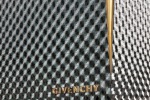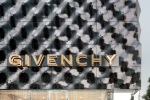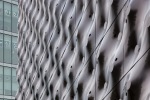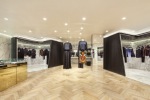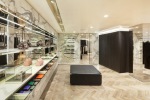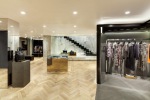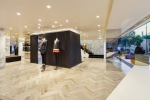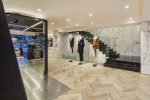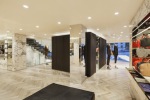Givenchy's new Seoul boutique is located at no. 78-11 on the prestigious Cheongdam Dong street, in the Gangnam Gu fashion district. Designed by Piurarch it covers 400 square metres. It is divided into four floors and arose from the meeting between the original concept of Givenchy's creative director Riccardo Tisci and the special experimental spirit which characterises the Milan architects Piuarch.
The building has a graphic geometrical structure, with an oil-slick finish, and a hyper-minimalist interior which reflects the themes and the allure of the brand, designed to emphasise the contrast with the products. The four floors of the building house the men's, women's and accessories collections of the celebrated brand which offers a unique vision of ready-to-wear luxury, both urban and couture.
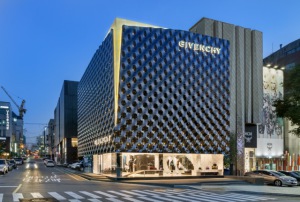
Designed as a sort of enclosure, the building's facade is a kind of second skin in rilief: an expression of an urban identity which grows out of the evocation of the characteristic tailoring “T” cut for which the French brand is well-known. The embossed surface of the electropolished steel panels creates a changeable effect which alters according to the reflection of the light and of the surrounding landscape. At the top of the building the facade is peeled away in a quotation of the famous T cut, revealing a detail in satinized brass. Besides being a direct evocation of a characteristic Givenchy stylistic trope, this sign becomes a landmark for anyone going down the great Cheongdam street.
Inspired by Op Art and the processing of the fabrics used by Givenchy in its latest collections, the undulating sheet metal of the facade is punctuated by irregular openings which in the evening give an image of the building in a constant state of flux. Piuarch intended to express in the facade precisely the iconic and evocative element which has been assigned the task of representing the values which characterise Givenchy. To do this it has transferred the nature of a tailoring process onto an urban and sculptural scale: a polished black cube which rests on an entirely glazed ground floor.
The outer surface has a shape in bumpy relief, the metal reflects and deforms the light, generating kinetic/optical effects which make the facade seem in continuous change over the course of the day.
The theme of these embossed elements makes reference to Givenchy's stylistic experiments with materials, transported in Piuarch's vision into references to Italian art of the 1960s: Lucio Fontana and Enrico Castellani especially. The point of contact between Italian optical art and Givenchy is precisely the mark impressed by Riccardo Tisci, whose work is shot through with constant references to the artistic movements typical of Italian art.
The details in the fittings and the facade are designed to express an almost sartorial use of materials. The general concept of the interior design is expressed through idiosyncratic experimentation with materials: Calacatta marble, noir effect, basalt, which are placed alongside different elements to create a spirit which is elegant and at the same time contemporary. Particular importance is given to the internal staircase clad in Sahara noir marble, separated from the wall by ramps which climb in different directions.



